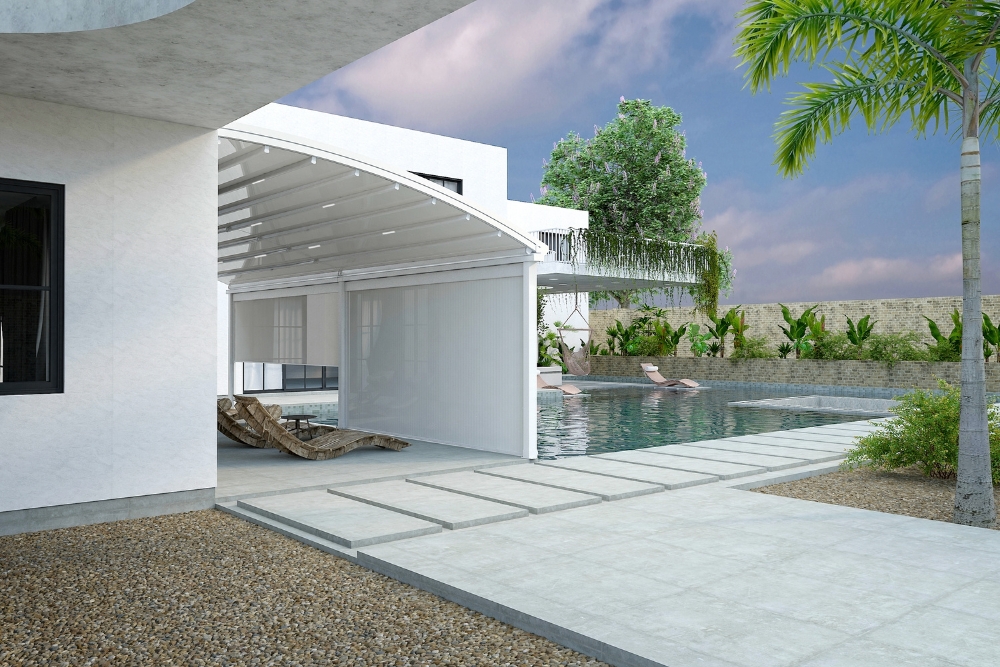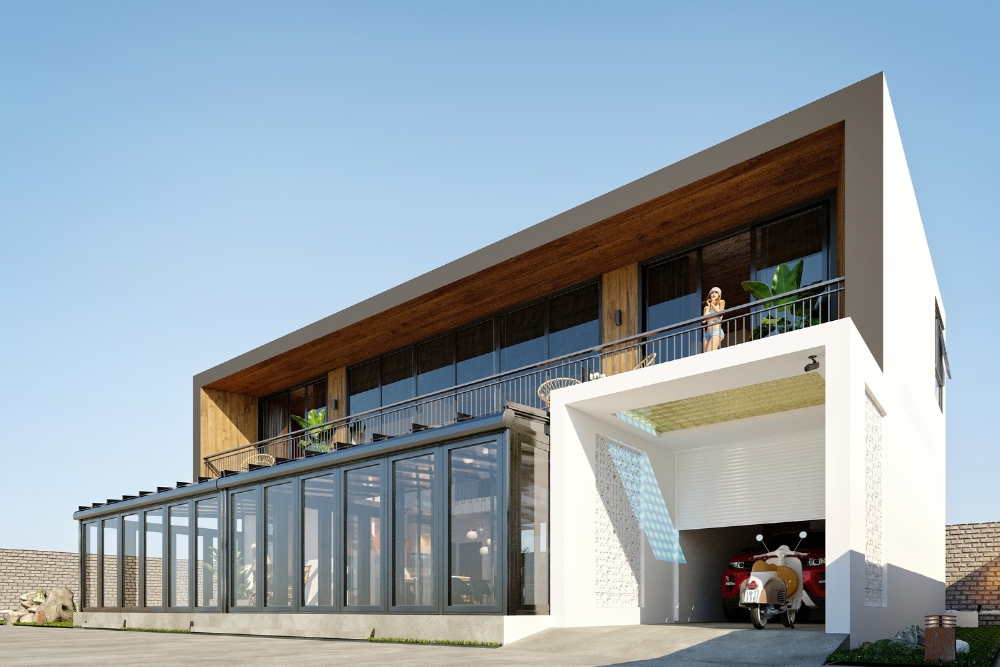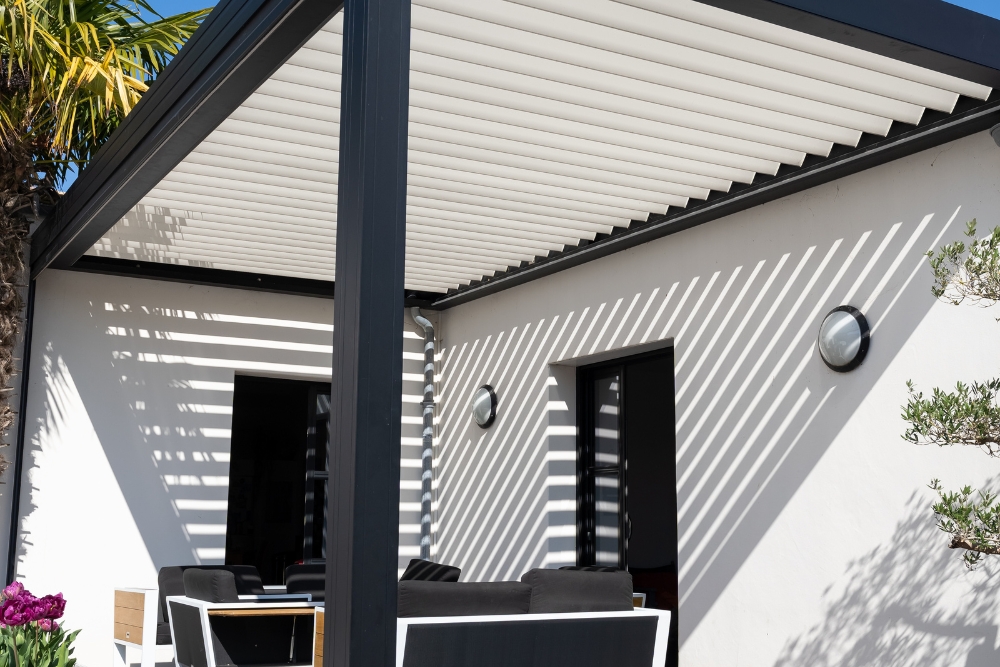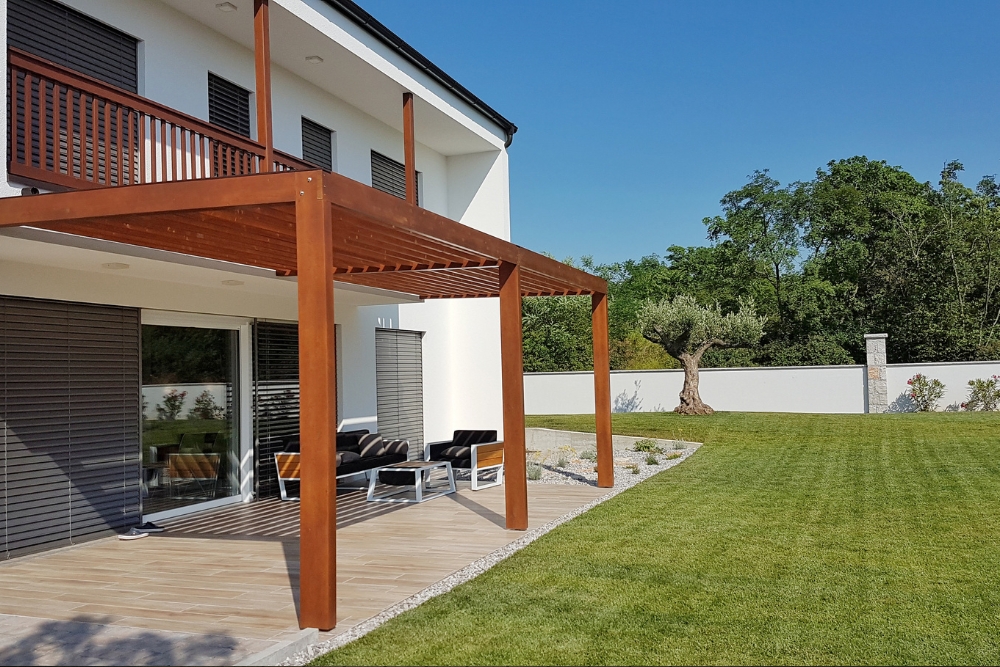Creating that perfect outdoor haven can be a bit of a puzzler, especially with Aussie weather throwing curveballs left, right and centre. We’ve all been there – trying to balance keeping our open-air lounges crisp and cool without ditching the style or practicality.
Opting for an aluminium pergola is one clever move; not only do they look sharp but they’re tough enough to stick it out through winds as gusty as 160 kilometres per hour. We’ve rolled up our sleeves and sussed out some top-notch design tweaks and savvy solutions to amp up your pergola’s breathability.
Our tips are set to turn your spot into the ultimate chill-out zone, even when the temperature’s on the climb. So hang tight – a refreshing outdoor retreat is just around the corner!
Key Takeaways
- Ventilation is essential in aluminium pergola design, promoting airflow and preventing moisture build-up, creating a comfortable outdoor living space.
- Aluminium pergolas incorporate various ventilation options such as louvred roofs, ridge vents, and gable vents to regulate temperature and improve air quality.
- Good ventilation reduces the risk of mould and mildew formation while increasing comfort by allowing natural airflow through the structure.
- The open design of aluminium pergolas ensures better airflow, minimising pollutants and allergens for a healthier outdoor environment.

The Importance of Pergola Design in Construction
Pergola design plays a crucial role in creating an outdoor retreat that enhances the comfort and functionality of your living space. It offers several advantages, from providing shade and shelter to adding architectural interest to your property.
Creating an outdoor retreat
We understand the allure of transforming our back gardens into a sanctuary. That’s why we’re passionate about integrating aluminium pergolas into your outdoor design. These structures offer more than just shade and shelter; they provide an essential layer of ventilation, ensuring you can enjoy your retreat even during the warmest days.
Imagine lounging beneath a louvred pergola that filters sunlight delicately while inviting in a gentle breeze—an open-air living room where comfort meets nature.
Crafting the perfect outdoor oasis involves considering how elements interact with one another. Our bioclimatic pergolas are masterfully designed to adapt to all weather conditions, enabling adjustable blades for personalised climate control at your fingertips.
Engage with the outdoors as never before knowing that robust aluminium construction ensures durability against high winds and changes in weather patterns, creating an investment that enhances both lifestyle and landscape for years to come.
Advantages in construction
Aluminium pergolas offer several advantages in construction, making them an ideal choice for outdoor spaces. Their lightweight yet durable nature allows for easy installation and long-lasting use.
Coupled with their ability to withstand high winds, aluminium pergolas provide a sturdy and reliable structure that homeowners can enjoy for years. Additionally, the low maintenance requirements of aluminium make it a cost-effective option, adding value to any outdoor living area.
The weather-resistant properties of aluminium further contribute to its appeal in construction, ensuring that the pergola stays strong and attractive regardless of environmental conditions.
Homeowners can rest assured knowing that their aluminium pergola will continue to provide shade and ventilation while maintaining its visual appeal over time. This makes it an excellent investment for creating a comfortable and inviting outdoor retreat.
The Role of Ventilation in Pergola Design
Good ventilation in pergola design plays a crucial role in promoting air flow, regulating temperature, and preventing moisture build-up. It ensures a comfortable outdoor living space and helps maintain the overall structural integrity of the pergola.
Promotes airflow
Aluminium pergolas promote airflow, allowing fresh breezes to circulate through your outdoor living space. The open design of an aluminium pergola helps in ventilating the area and keeps it cooler during the hot summer months.
Louvred roofs and adjustable slats ensure that you can control the amount of airflow, creating a comfortable environment for relaxing or entertaining.
Additionally, natural ventilation reduces the risk of moisture build-up and mould, providing improved air quality for your outdoor retreat. By incorporating efficient ventilation techniques into your aluminium pergola design, you’ll create a welcoming and enjoyable space for all seasons.
Helps regulate temperature
Regulating temperature is vital in creating a comfortable outdoor living space. With aluminium pergolas, the natural ventilation they provide helps regulate temperature by allowing airflow and preventing heat build-up.
This promotes a pleasant environment during the hot summer months, keeping the area beneath the pergola cooler and more enjoyable.
In addition to shade, ventilation is an essential aspect of pergola design that contributes to maintaining optimal temperatures for your outdoor living spaces. By promoting air circulation and reducing heat retention, proper ventilation plays a key role in ensuring your comfort when relaxing or entertaining outdoors under your aluminium pergola.
Prevents moisture build-up
Aluminium pergolas with proper ventilation prevent moisture build-up, keeping the outdoor living space dry and comfortable. This feature is essential for maintaining a pleasant environment under the pergola, as it helps reduce the risk of mould and mildew formation.
With effective ventilation systems such as louvred roofs or ridge vents, moisture is regulated, ensuring that air quality remains optimal while protecting against humidity-related damage.
Good ventilation in aluminium pergolas also promotes airflow, preventing stagnation and creating a more enjoyable outdoor experience. By allowing natural airflow to circulate through the structure, homeowners can enjoy their open-air living space without concerns about excessive humidity or moisture accumulation.
Types of Ventilation in Aluminum Pergola Design
There are various types of ventilation that can be incorporated into aluminium pergola designs, such as louvred roofs, ridge vents, and gable vents. Each type offers different benefits and levels of airflow for your outdoor space.

Louvered roofs
Aluminium pergolas often incorporate louvered roofs, featuring adjustable slats that can be angled to control the amount of sunlight and ventilation entering the outdoor space. This design allows homeowners to manage heat and light according to their preferences, creating a comfortable outdoor living environment.
Louvred roofs made of aluminium provide natural ventilation when opened, allowing fresh air to flow through while regulating temperatures beneath the pergola. The ability to adjust the louvres ensures that homeowners can enjoy open-air living spaces with customisable shade and shelter.
With a wall-mounted pergola structure equipped with louvred roofing, homeowners can benefit from improved air quality and temperature regulation in their outdoor retreats. Additionally, motorised pergola ventilation enhances convenience by enabling effortless adjustment of the louvres based on weather conditions or personal preference.
Ridge vents
Ridge vents are an effective way to promote air circulation in your aluminium pergola. By installing ridge vents along the peak of the roof, hot air is able to escape naturally, helping to regulate the temperature and create a more comfortable outdoor environment.
This type of ventilation also prevents moisture build-up by allowing for continuous airflow, reducing the risk of mould and mildew. Ridge vents are a key feature in ensuring that your pergola provides improved air quality and a pleasant living space for you and your family.
Having ridge vents in your aluminium pergola design allows for better heat management during the hot summer months. These openings at the top of the structure provide passive cooling, making your outdoor space more enjoyable even on scorching days without compromising its weather resistance.
Gable vents
Transitioning from ridge vents, gable vents are another essential component of aluminium pergola design to maximise natural ventilation. Gable vents are strategically placed in the end walls of the pergola structure, allowing hot air to escape and fresh air to enter, creating a continuous flow that helps regulate the temperature and keep the space comfortable.
The inclusion of gable vents in aluminium pergolas enhances airflow, preventing moisture build-up and ensuring improved air quality within the outdoor living space.
Benefits of Good Ventilation in Pergola Design
Good ventilation in pergola design leads to improved air quality, reduced risk of mould and mildew, and increased comfort for outdoor living spaces. To learn more about the importance of ventilation in aluminium pergola design, keep reading!
Improved air quality
Aluminium pergolas play a crucial role in enhancing air quality in outdoor living spaces. The natural ventilation provided by aluminium pergolas ensures that fresh air circulates freely, reducing the risk of stale and stuffy air.
This improved air quality creates a more comfortable environment for relaxation and entertaining, contributing to an overall healthier outdoor living experience.
In addition, the open design of aluminium pergolas allows for better airflow, helping to minimise pollutants and allergens. As a result, homeowners can enjoy their outdoor space with confidence, knowing that they are breathing cleaner air while basking in the natural beauty of their customised pergola design.
Reduced risk of mold and mildew
Good ventilation in your aluminium pergola helps decrease the risk of mould and mildew. Proper airflow prevents moisture from accumulating, reducing the likelihood of mould growth.
By allowing air to circulate freely, your pergola’s ventilation system ensures a healthier outdoor living space, protecting both your family and the structure itself.
Moreover, effective ventilation in an aluminium pergola design contributes to maintaining a clean and fresh environment under its shade. It minimises the presence of dampness that often leads to musty odours and mould formation.
Increased comfort
Aluminium pergolas provide increased comfort in outdoor living spaces. With natural ventilation, these structures allow for a cooler environment during the hot summer months, creating an enjoyable and relaxing retreat.
The adjustable louvres or slats can control the amount of sunlight and ventilation, offering homeowners the flexibility to customise their outdoor space to suit their needs.
Furthermore, aluminium pergolas are designed to withstand wind speeds of up to 100 miles per hour, ensuring peace of mind for homeowners while providing a durable and long-lasting solution for shade and ventilation.

Considerations for Ventilation in Aluminum Pergola Design
When designing an aluminium pergola, it’s important to consider the location and surrounding environment, as well as the types of materials used. These factors can impact the overall ventilation and energy efficiency of your outdoor living space.
Location and surrounding environment
Consider the location and surrounding environment when planning the placement of your aluminium pergola. Take note of the direction of prevailing winds to optimise natural ventilation and ensure a comfortable outdoor living space.
Additionally, assess the amount of sunlight the area receives throughout the day to determine how much shade your pergola will need, making it an inviting retreat for all seasons.
Evaluate whether nearby trees or structures might obstruct airflow, affecting the effectiveness of natural ventilation within your pergola. By taking these factors into consideration during design and construction, you can maximise the benefits of your aluminium pergola in creating a pleasant outdoor living space for years to come.
Types of materials used
When considering the types of materials used for your aluminium pergola, it’s important to prioritise durability and longevity. Aluminium is a popular choice due to its light weight, strength, and resistance to corrosion.
This makes it an ideal material for withstanding various weather conditions while requiring minimal maintenance. Additionally, aluminium provides the flexibility needed for creating intricate designs and architectural features that can enhance the aesthetics of your outdoor space.
Another material option to consider is steel, which also offers exceptional durability and structural support. However, it may require more maintenance compared to aluminium due to its susceptibility to rust if not properly treated or coated.
Both materials contribute to the overall robustness of your pergola design, ensuring that you can enjoy a long-lasting shade structure in your outdoor living area.
Impact on energy efficiency
Considering the types of materials used in aluminium pergola design, it’s important to recognise the impact on energy efficiency. The choice of material plays a vital role in ensuring that the pergola provides effective ventilation while maintaining energy efficiency.
With aluminium’s lightweight and durable nature, it allows for natural air circulation and effectively regulates temperature, thus reducing the need for excessive artificial cooling or heating systems.
This not only creates a comfortable outdoor living space but also contributes to lower energy consumption, making aluminium pergolas an eco-friendly choice.
Furthermore, incorporating proper ventilation through an aluminium pergola design can significantly enhance energy efficiency by minimising reliance on electric fans or air conditioning units.
Elevate Your Space with Aluminium Pergolas
In conclusion, ventilation plays a crucial role in aluminium pergola design. It promotes airflow, helps regulate temperature, and prevents moisture build-up. Different types of ventilation, such as louvred roofs and ridge vents, provide improved air quality and increased comfort in outdoor living spaces.
When considering an aluminium pergola design, the location and surrounding environment should be taken into account to ensure efficient natural ventilation for an inviting outdoor retreat.
Experience the breath of fresh air in outdoor living! Discover the perfect synergy of style and ventilation with Aluminium Pergolas. Elevate your space with intelligently designed Aluminum Pergolas that prioritise airflow, ensuring a cool and comfortable environment. Breathe life into your outdoor oasis while enjoying the benefits of thoughtful ventilation. Explore the art of sophisticated design and functionality with Aluminium Pergolas. Transform your outdoor living into a haven of fresh, invigorating air. Connect with us today and redefine your space with Aluminum Pergolas – where design meets the essence of the outdoors!




